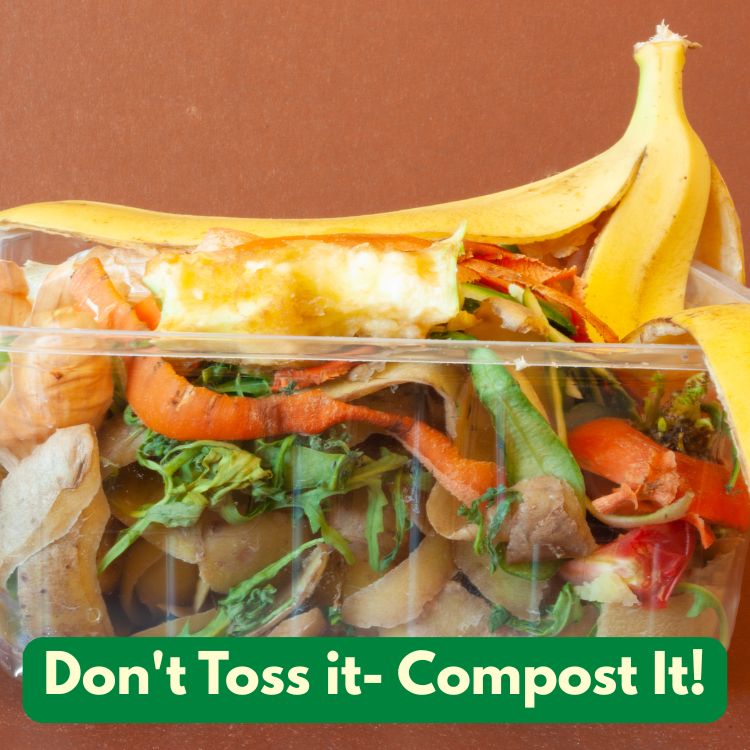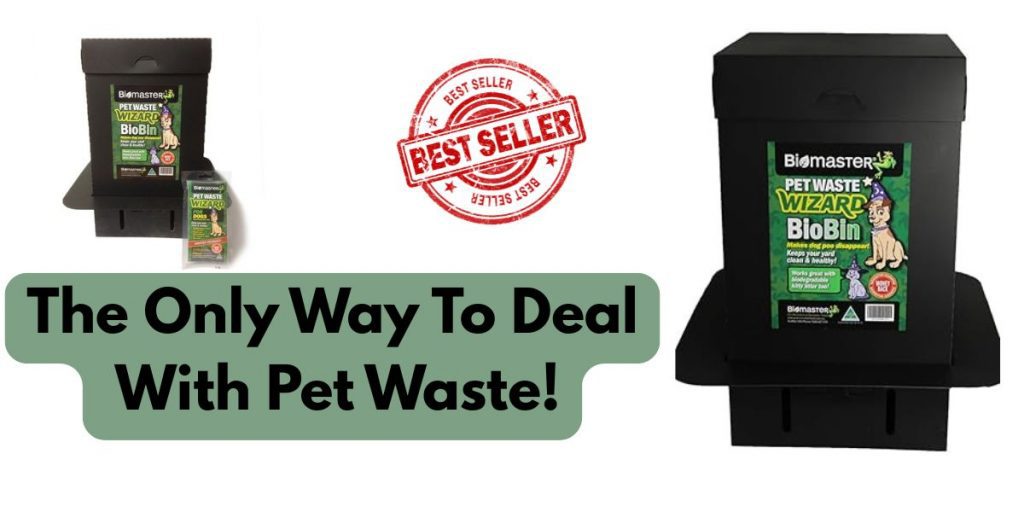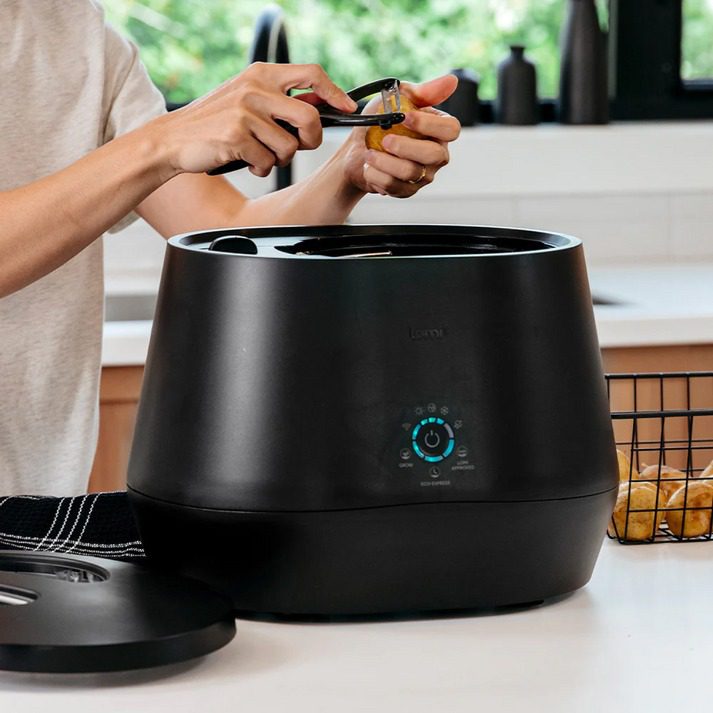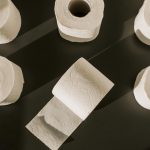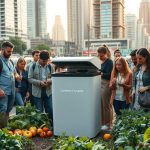Don’t Toss it- Compost It!
Adopting the habit of composting at home can make a big difference. It not only cuts down on waste but also supports the environment. This simple action helps a lot.
Composting is a key way to reduce your carbon footprint. Studies show it can pull carbon dioxide out of the air.
It also boosts crop yields, making it crucial for a green future.
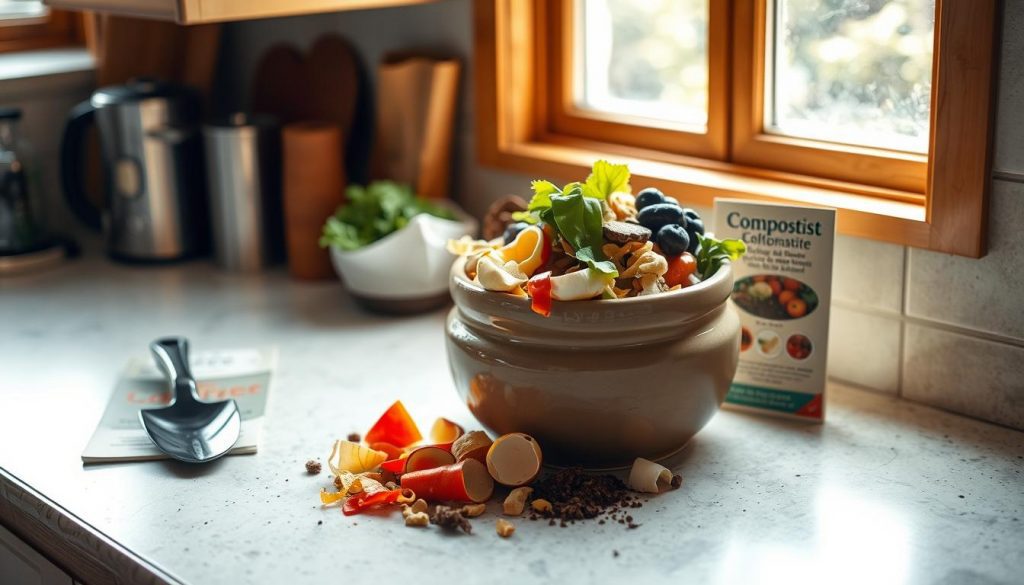
By composting, you’re doing a lot to help the planet. It’s a simple yet powerful way to make a difference.
It’s a step towards a cleaner, greener world.
Key Takeaways
- Composting at home reduces waste and supports eco-friendly practices.
- It helps decrease carbon dioxide levels in the air.
- Composting can lead to increased yields and a more sustainable future.
- Adopting composting habits is a simple way to make a positive environmental impact.
- It’s an effective method for reducing your carbon footprint.
The Hidden Value in Your Trash
Did you know your trash can be a treasure for your garden? Composting turns kitchen waste and household scraps into something valuable. It’s a simple way to help the environment.
Composting cuts down on landfill waste and makes soil better for plants. It also helps fight climate change.
Food waste, in particular, is a big problem when it breaks down in landfills, releasing methane.
Why Composting Matters for Your Garden and the Planet
Composting is important for two big reasons: it manages waste and improves soil. By composting, you make a natural fertilizer.
This helps plants grow without harmful chemicals.
Common Misconceptions About What Can Be Composted
Many think only some waste can be composted. But, lots of things can be turned into compost. For instance, coffee grounds, eggshells, and even hair can be composted.
Knowing what can and can’t be composted is crucial.
| Compostable Items | Benefits |
|---|---|
| Kitchen waste (food scraps) | Rich in nutrients, improves soil fertility |
| Coffee grounds and tea bags | High in nitrogen, supports microbial growth |
| Eggshells | Adds calcium, improves soil structure |
Top Household Scraps People Forget to Compost
Many household scraps can be composted, reducing waste and improving your garden soil. While we know fruit and vegetable peels can go into the compost, there’s more.
Many other items can be added to make your soil rich and fertile.

Beyond Fruit and Vegetable Peels
Coffee grounds and tea bags are full of nitrogen, speeding up composting. Eggshells add calcium and minerals, helping plants grow well.
Surprising Items You Didn’t Know Were Compostable
Some items might surprise you, like hair and nail clippings, which are rich in nitrogen. Even butter wrappers and bones can go into the compost.
But, they might attract pests if not managed right.
Items to Avoid in Your Compost Pile
Not everything can be composted. Stay away from meat, dairy, and oily foods to avoid pests and bad smells.
Also, pet waste and diseased plant materials should not go in to prevent disease spread.
Top Tip: If you want to have a separate compost pile FOR pet waste, that compost can be used on non edible flowers for your garden.
Kitchen Waste Gold: Overlooked Food Scraps
Kitchen scraps are more than trash. They can be the start of a green gardening practice.
By composting, you cut down on landfill waste and make soil for your garden.
Many kitchen items can be composted, and some might surprise you. Let’s look at some food scraps that can turn into valuable compost.
Coffee Grounds and Tea Bags
Coffee grounds and tea bags are full of nitrogen. They’re great for your compost pile. They balance out the carbon-rich materials and help with decomposition.
How They Benefit Your Compost
These materials are not just rich in nitrogen. They also attract good microorganisms. Coffee grounds, in particular, can lower your compost’s pH.
This helps with microbial growth.
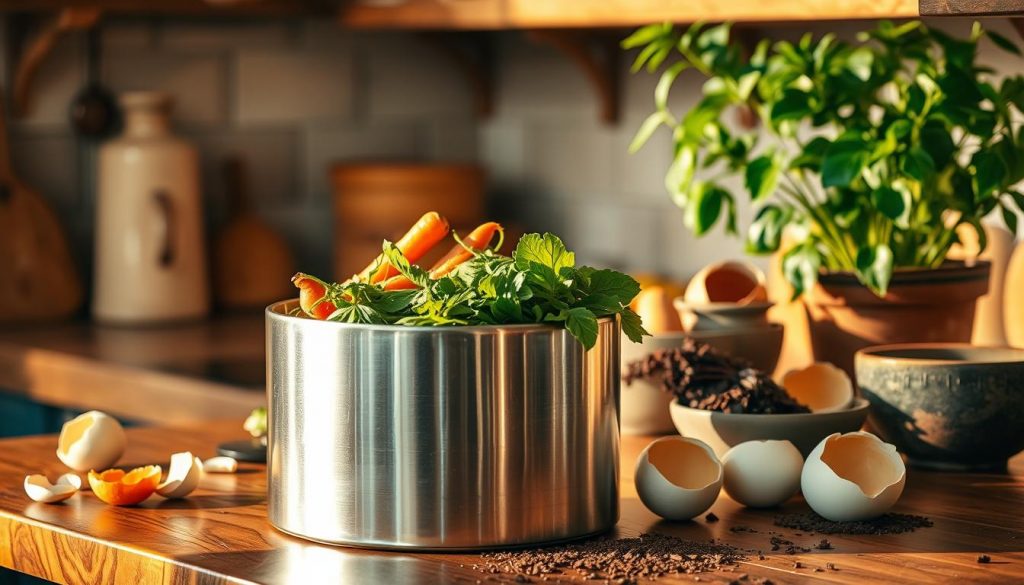
Eggshells and Nutshells
Eggshells and nutshells add calcium and minerals to your compost. They help plants and improve soil structure by making it more porous.
Proper Preparation Tips
To compost eggshells and nutshells well, crush them into small pieces. This makes them break down faster.
Stale Bread, Pasta, and Grains
Stale bread, pasta, and grains are high in carbon. They help balance your compost’s nitrogen levels.
They’re good for keeping the ‘green’ and ‘brown’ material ratio right.
| Kitchen Scrap | Nutrient Contribution | Preparation Tip |
|---|---|---|
| Coffee Grounds | Nitrogen, Microbial Support | Add directly to compost |
| Eggshells | Calcium, Soil Structure | Crush before adding |
| Stale Bread | Carbon, Energy Source | Break into smaller pieces |
By adding these kitchen scraps to your compost, you reduce waste. You also make your compost more diverse and nutrient-rich for your garden.
Paper Products You Can Add to Your Compost Pile
You can make your compost pile better by adding different paper products. This supports your green practices and helps with recycling. Using these materials at home makes composting more effective.
Paper products have a lot of carbon. This is good for balancing out the nitrogen in your compost, like food scraps.
A balanced compost pile decomposes well and efficiently.
Cardboard and Paper Towel Rolls
Cardboard and paper towel rolls are great for compost. They have a lot of carbon and soak up extra moisture. Shred or tear them into small pieces before adding to your compost.
Newspaper, Junk Mail, and Shredded Paper
Newspaper, junk mail, and shredded paper are also good for compost. They have a lot of carbon and balance out the nitrogen.
But, avoid glossy or colored paper because it might have harmful chemicals.
Paper Products to Avoid
Not all paper is good for composting. Stay away from glossy, colored, or coated paper because it can harm your compost.
Also, don’t compost paper with food or grease, as it can attract pests.
| Paper Product | Compostable | Notes |
|---|---|---|
| Cardboard | Yes | Shred or tear into smaller pieces |
| Newspaper | Yes | Avoid glossy or colored inserts |
| Shredded Paper | Yes | Ensure it’s not contaminated with grease or food |
| Glossy Paper | No | May contain harmful chemicals |
Bathroom and Personal Care Items for Composting
Composting isn’t just for kitchen scraps. Many bathroom and personal care items can also be composted. This turns them into nutrient-rich soil.
By adding these items to your compost pile, you reduce waste and live more sustainably.
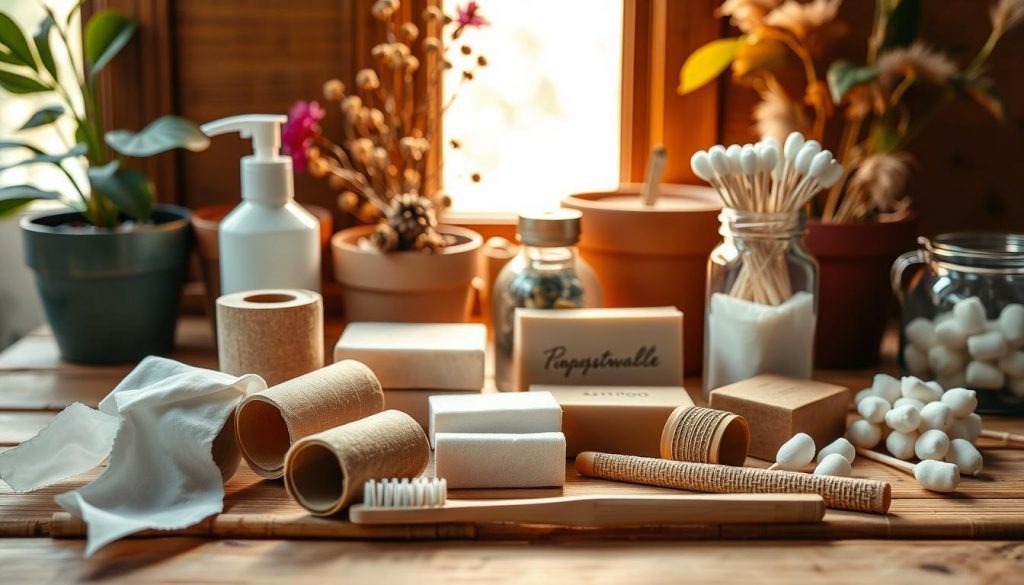
Hair, Nail Clippings, and Cotton Products
Hair and nail clippings are full of nitrogen, making them great for compost. Cotton products like cotton balls and swabs (without plastic sticks) also compost well.
They help balance the carbon-to-nitrogen ratio in your compost pile.
Toilet Paper Rolls and Natural Loofahs
Toilet paper rolls and natural loofahs are carbon-rich and can be composted. They soak up moisture and add structure to your compost pile.
Make sure any loofahs are free from synthetic materials.
Dryer Lint and Dust Bunnies
Dryer lint and dust bunnies can be composted if they’re from natural fibers. They’re high in carbon and balance out the nitrogen-rich materials.
But, avoid adding lint or dust with synthetic fibers.
Yard Waste Beyond Leaves and Grass
Your yard has more than just leaves and grass to compost. Exploring these materials can help you reduce waste and make nutrient-rich compost.
This is great for your garden.
Twigs, Small Branches, and Pine Needles
Twigs and small branches can be composted, but they take longer. Cutting them into smaller pieces helps them break down faster.
Pine needles are acidic but can be composted in small amounts. They add carbon and balance out the compost pile.
Dead Houseplants and Flowers
Don’t throw away dead houseplants and flowers. They’re full of nutrients and can make your soil better.
Just make sure to remove any plastic pots or non-biodegradable items first.
Autumn Leaves and Holiday Trees
Autumn leaves are great for composting, full of carbon. Shredding them before adding helps them break down quicker.
Holiday trees can also be chipped and added, providing more carbon.
| Yard Waste | Composting Tips | Benefits |
|---|---|---|
| Twigs and Branches | Chop into smaller pieces | Adds carbon, improves structure |
| Pine Needles | Use in moderation | Rich in carbon, acidic |
| Dead Houseplants | Remove non-biodegradable parts | Rich in nutrients |
Adding these yard wastes to your compost is good for the environment. It makes your gardening more sustainable. 
Pet-Related Items You Can Compost
Composting isn’t just for kitchen scraps. Many pet-related items can also be turned into nutrient-rich soil.
As a pet owner, you’re likely accumulating various waste materials that can be repurposed.
Herbivore Pet Bedding and Droppings
If you have pets like guinea pigs, rabbits, or hamsters, their bedding and droppings can be composted.
These materials are rich in nutrients and can enhance soil fertility.
Guinea Pigs, Rabbits, and Hamsters
The waste from these small herbivores is particularly beneficial due to its high nitrogen content. Make sure the bedding is free from synthetic materials and chemicals.
Pet Hair and Feathers
Pet hair and feathers can also be added to your compost. They are high in nitrogen, which is essential for balancing the carbon-rich materials in your compost pile.
Here’s a comparison of the nitrogen content in different pet-related items:
| Material | Nitrogen Content |
|---|---|
| Pet Hair | High |
| Feathers | High |
| Herbivore Droppings | Moderate to High |
By composting these pet-related items, you’re not only reducing waste but also creating a valuable resource for your garden. This practice supports eco-friendly living and enhances soil health.
Setting Up Your Composting System
Turning your trash into compost starts with a good composting setup. You can compost whether you have a big backyard or a small apartment.
There’s a composting method for everyone.
Outdoor Composting Options
Outdoor space makes composting easy. Just pick a spot in your yard for a compost pile. But, a compost bin or tumbler keeps things neat and tidy.
Indoor and Apartment Composting Solutions
Composting indoors is possible too. Vermicomposting and Bokashi composting work well in tight spaces.
They help you reduce waste at home.
When picking your composting setup, think about a few things:
- How much space you have
- The type and amount of waste you have
- How much effort you’re willing to put into it
Choosing the right composting method helps you recycle organically. It also cuts down on household waste.
Click Here to get this fabulous Lomi Countertop Composter
Balancing Your Compost: The Green and Brown Ratio
Creating the perfect compost mix is an art. It needs a balance between green and brown materials.
This balance helps in decomposition and makes compost rich for your garden.
Understanding Nitrogen and Carbon Materials
Green materials have lots of nitrogen. Brown materials have lots of carbon. Kitchen scraps, grass clippings, and manure from herbivores are nitrogen-rich.
Dry leaves, straw, and shredded newspaper are carbon-rich.
Identifying Greens and Browns in Your Home
Knowing what’s green and brown at home is key. Greens are wet and full of nitrogen. Browns are dry and full of carbon.
Coffee grounds, tea bags, and eggshells are greens. Cardboard, paper towel rolls, and dryer lint are browns.
Achieving the Perfect Compost Mix
The perfect compost mix is 2/3 brown and 1/3 green. Here’s how to get it:
- Start with brown materials at the bottom.
- Put green materials on top of the brown.
- Keep alternating between brown and green layers.
- Keep the pile moist and turn it often.
By balancing your compost mix, you’ll get a nutrient-rich compost. It’s great for your garden’s health and growth.
Troubleshooting Common Composting Problems
Composting can be a bit unpredictable, but knowing how to fix common issues helps a lot. You might face problems like bad smells, pests, or slow breakdown.
These issues often come from an unbalanced compost pile or poor air flow.
Dealing with Odors and Pests
Odors and pests are common in composting. They usually happen when the compost pile is off balance. Make sure you have the right mix of green and brown materials.
- Add more brown materials like dried leaves or straw to soak up extra moisture and cut down on smells.
- Regularly turn the compost pile to improve air flow and speed up the breakdown process.
Natural Solutions for Compost Issues
For tough odors or pests, natural solutions can help. Mixing in dolomitic limestone or crushed eggshells can balance acidity and keep pests away.
You can also use diatomaceous earth, a natural pest repellent.
Fixing Slow Decomposition Issues
Slow decomposition can be a problem, but it’s often simple to fix. Make sure your compost pile isn’t too dry or cold.
These conditions slow down the microbes. Keep the pile moist, like a damp sponge, and add more nitrogen-rich materials to speed things up.
By tackling these common composting problems and using eco-friendly practices, you can keep your compost pile healthy. This will help your garden and the environment too.
Conclusion: Transform Your Waste into Garden Treasure
Composting is a simple yet powerful way to cut down on household waste. It makes a nutrient-rich soil amendment for your garden.
By doing this, you’re not only reducing waste but also living more sustainably.
Composting is like magic, turning waste into something valuable. It takes patience, but the benefits are huge. As you compost, you’ll see how it improves your garden and the environment.
So, start composting today and turn your waste into garden gold. Every coffee ground, eggshell, and yard trimmings you add helps the planet.
Composting daily reduces waste, supports green living, and fosters a sustainable lifestyle.

